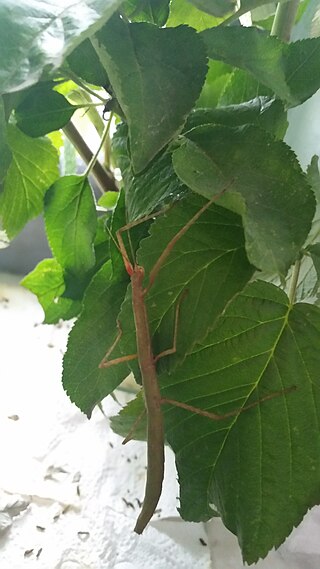
Carausius is a genus of the tribe Lonchodini, in the order Phasmatodea. The genus is in many ways typical of the Phasmatodea in that all species are twig-like in appearance. These species are parthenogenetic.

The Euphasmatodea, also known by its junior synonym Verophasmatodea is a suborder of the Phasmatodea, which contains the vast majority of the extant species of stick and leaf insects, excluding the Timematodea. The oldest record of Euphasmatodea is Araripephasma from the Crato Formation of Brazil, dating to the Aptian stage of the Early Cretaceous.

Phobaeticus is a genus of Asian stick insects comprising over 25 species. The genus includes some of the world's longest insects.
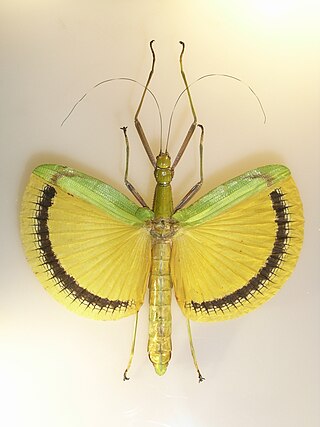
Necrosciinae is a subfamily of the stick insect family Lonchodidae, with its greatest diversity in South-East Asia.
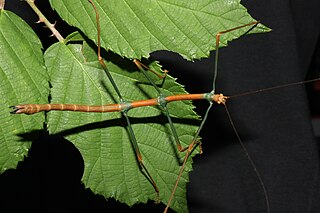
Lonchodes is a genus of stick insects in the family Phasmatidae and the type genus of the family Lonchodidae and tribe Lonchodini. Species have a known distribution that includes tropical Asia and the Pacific.

Ramulus is an Asian genus of stick insects in the family Phasmatidae and tribe Clitumnini.

Sipyloidea is a genus of stick insects of the family Lonchodidae. Species have been recorded from India, China, Indochina, through to Australasia. The genus was described by Brunner von Wattenwyl in 1893.

The Clitumninae are a sub-family of stick insects in the family Phasmatidae found in Asia. The type genus Clitumnus is now considered a synonym of Ramulus.

The Lonchodinae are a subfamily of stick insects in the family Lonchodidae found in: Australasia, Asia, Africa, Southern America and the Pacific.

Medauroidea is an Asian genus of stick insects in the family Phasmatidae and subfamily Clitumninae. Species have been recorded from Indo-China.

The Gratidiini are a tribe of stick insects based on the type genus Clonaria and first used by Cliquennois in 2005. Genera are known to be distributed in: Africa, Europe, temperate and tropical Asia and various Pacific Islands.

The Platycraninae are an anareolate subfamily of stick insects in the family Phasmatidae. Their known distribution includes southern, southeast Asia and Australasia.
Baculonistria is a genus of phasmids belonging to the family Phasmatidae, with records from China.

The Cladomorphinae are a subfamily of stick insects in the family Phasmatidae. This taxon is particularly well represented in the Neotropical region, but records also exist for Madagascar, Java and the Maluku Islands.
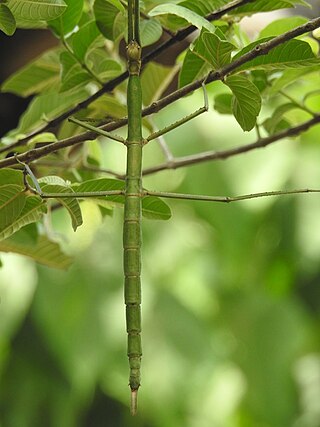
Nesiophasma is a genus of very large stick insects within the order Phasmatodea and the tribe of Stephanacridini. This genus is found in Wallacea west of Weber’s Line: Sulawesi, Peleng Island, Selayar Island, Kalaotoa Island, Sanana Island, Romang Island, Timor Island, Sangihe Island and Talaud Islands. New Guinea with doubt. The largest in the list of species is Nesiophasma giganteum, with females reaching a body length of 30 cm.
Rhamphophasma is a genus of stick insects in the tribe Clitumnini, erected by Carl Brunner von Wattenwyl in 1893. Species have been recorded from: China, Vietnam, India, Myanmar and Japan.
Metentoria is a genus of stick insects in the tribe Clitumnini, erected by Carl Brunner von Wattenwyl in 1907. Species have been recorded from: India and Vietnam.
Prosentoria is a genus of stick insects in the tribe Clitumnini, erected by Carl Brunner von Wattenwyl in 1907. Species have been recorded from: Vietnam and Borneo.
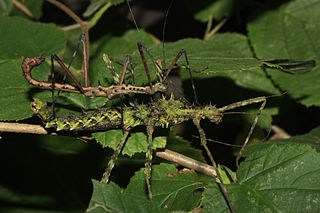
Andropromachus is a genus of Asian stick insects in the tribe Necrosciini, erected by Johann Carl in 1913. Species have been recorded from south-western China and northern Vietnam.

Neohirasea is a genus of stick insects in the tribe Necrosciini, erected by J.A.G. Rehn in 1904. Species has been recorded from temperate and tropical Asia, including: China, India, Japan, Malaysia and Vietnam.















